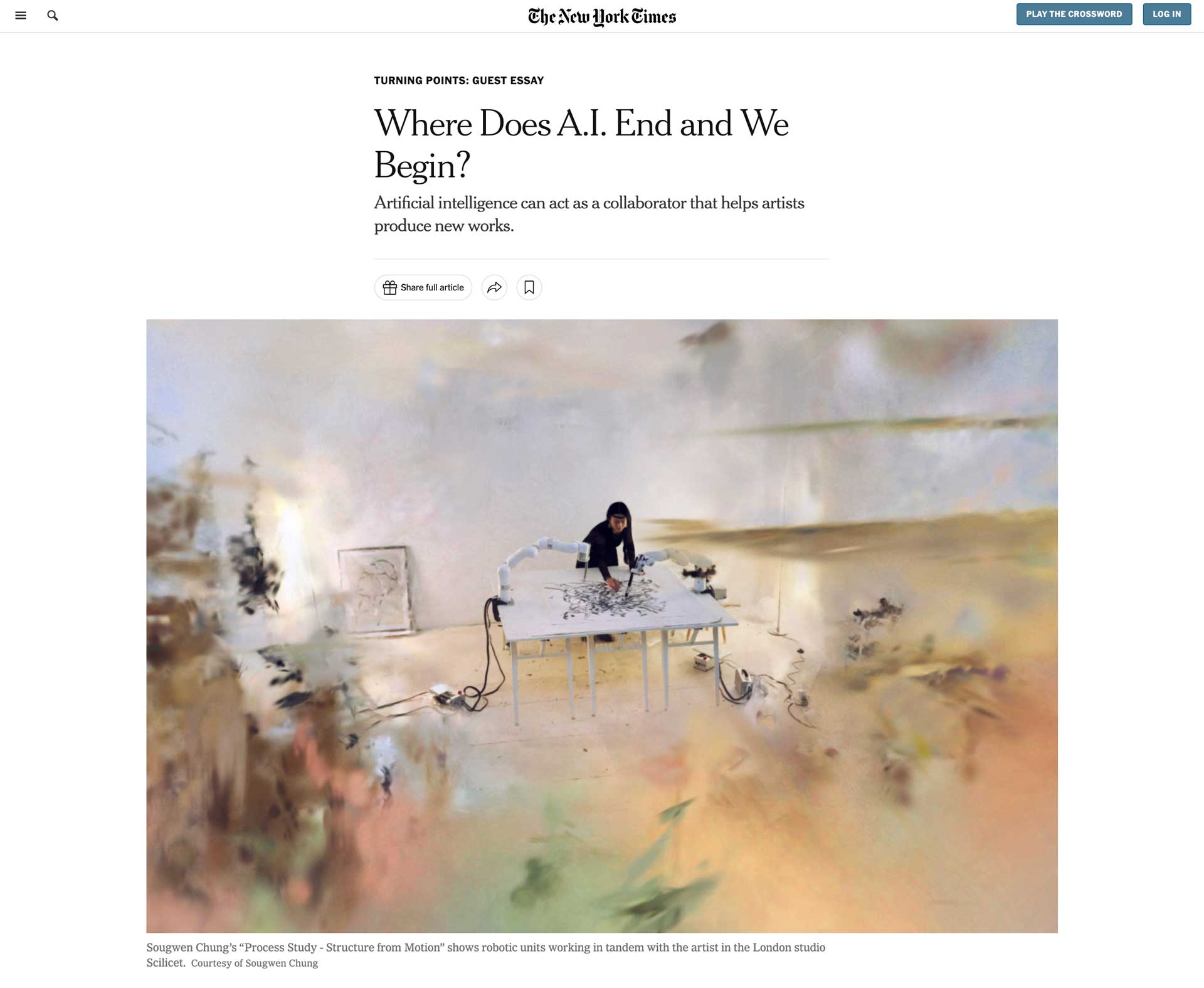Chung, Sougwen. “Where Does A.I. End and We Begin?” The New York Times, The New York Times, 7 Dec. 2023, www.nytimes.com/2023/12/07/special-series/artificial-intelligence-art.html?unlocked_article_code=1.EE0.eiMW.j35PQKm8GJih&smid=url-share.
Where does A.I. end and we begin?
I’ve been thinking about this question — the line between machines and human creativity — for a long time. In my art, lines are governing elements over images. But what happens when those lines are made by a machine?
In 2015, I began my journey in co-creation. It took two years to meticulously scan more than 20 years’ worth of my drawings into a system I developed to train a recurrent neural network. The neural network drives the movements of D.O.U.G., short for Drawing Operations Unit: Generation 2, a robot I built to draw with me. We made our debut in 2017. Today, I’m continuing to explore emerging technology — biosensors, computer vision, virtual reality and custom machines. It’s been nearly a decade. I wonder, with all these technological adaptations, what will become of the human hand?

In the years since the Covid-19 pandemic, I’ve seen colleagues close their artistic practices out of disillusionment or pragmatism, often a combination of both. Yet, because of the proliferation of the digital art market of nonfungible tokens, cryptocurrency and generative artificial intelligence systems — technology that can produce images — I’ve seen the igniting of a new generation of digital artists, and witnessed new studios emerge and flourish.
It’s a strange time to make art. In 2023, industries were in revolt — from the 148-day screenwriters strike in the United States to artists rightfully condemning the use of A.I. training data without their consent. It’s not news that researchers have cautioned against the dangers of bias in A.I.; that almost seems a given. Another problem is that not everyone knows the hidden cost of accumulating the data involved in making sense of massive language models like OpenAI’s GPT-4. At the same time, linking prompts with image generation and coding has popularized a new relationship between text and image. Now more people than ever can communicate through a visual medium, a new entry point for learning to code. ChatGPT can function as a sidekick you can talk to, which can help build a sense of rapport between A.I. systems and humans.
With all the hype, it’s easy to forget that there’s no such thing as a single artificial intelligence because there’s no such thing as a single natural intelligence. I’ve come to think of my approach of learning through systems — deemed intelligent or otherwise — as a creative catalyst. There is meaning in the data, but it’s not the meaning we are given; it’s the meaning we make.

For me, meaning-making and experimentation go hand-in-hand. In “Process Study - Structure from Motion,” I’m experimenting with a new way of capturing an environment. The technique is called “gaussian splatting,” a diffuse scanning approach to 3-D space. It gleans structure from motion, yielding a dense representation of objects that, to my eyes, also yields painterly and ghostly visual artifacts. I’m drawn to this approach because of its future possibilities — new applications of Embodied A.I. — as well as its effect in the present day. It shows the incompleteness of digital representation and the texture of the system as its own kind of beauty.
The themes of beauty and fragility ground my experimentations, often involving the sharing of the time and space of making art with machines. I’ve chronicled that evolution through performances, films and vignettes from my studio. For me, drawing is a way of being in the world. When I draw and create with my machines, this creative process allows me to engage with the technology alongside my physical instincts to form a kind of gestural relation. Showing the process in progress offers space for introspection.
I’ve recently finished the fifth generation of my robotic journey. Still, I feel like we’re just getting started with this type of art and our understanding of the role of technology in art. From mimicry, to memory, to the collectivity of the urban environment, to the spectrality of biofeedback, each generation unlocks a new set of technical skills, creating stronger relationships between humans and machines. With each development, I find myself with more questions than answers.

As I paint in collaboration with the robotic units in my studio, I’m hopeful that some of those tensions make their way into the painted line, the visual artifact on canvas. When people react to my work, I am often asked, “Can A.I. be creative?” But lately, I’m unsure if that’s the question we should be asking.
Artists have the privilege of responding to the social and political moments of their day. I’ve been designing alternative forms of machines inspired by nature, with the bond between humans and machines as one of ecological stewardship. As I develop these forthcoming configurations, the drawn line is one constant that always remains at the center. It is a line that explores the potential of human and machine collaboration, speculating on how the machine will act as a catalyst, co-pilot and companion. If I’ve learned anything in the past decade of this journey, it’s that art can help us ask better questions: Can fear and hope be held in the mind simultaneously? How do we grasp the promise, perils and paranoias of technical shifts at once?
Where does A.I. end and we begin?
Sougwen Chung is a Chinese-Canadian artist and the founder and artistic director of Scilicet, a London-based studio that works on examining human collaboration with machines.
